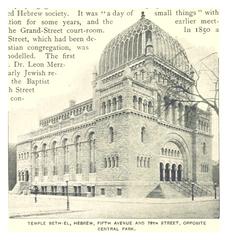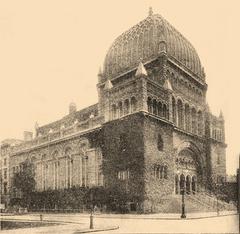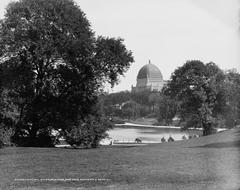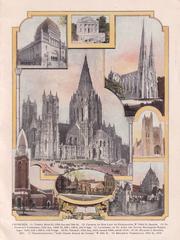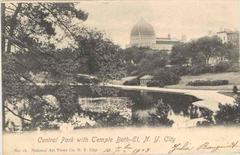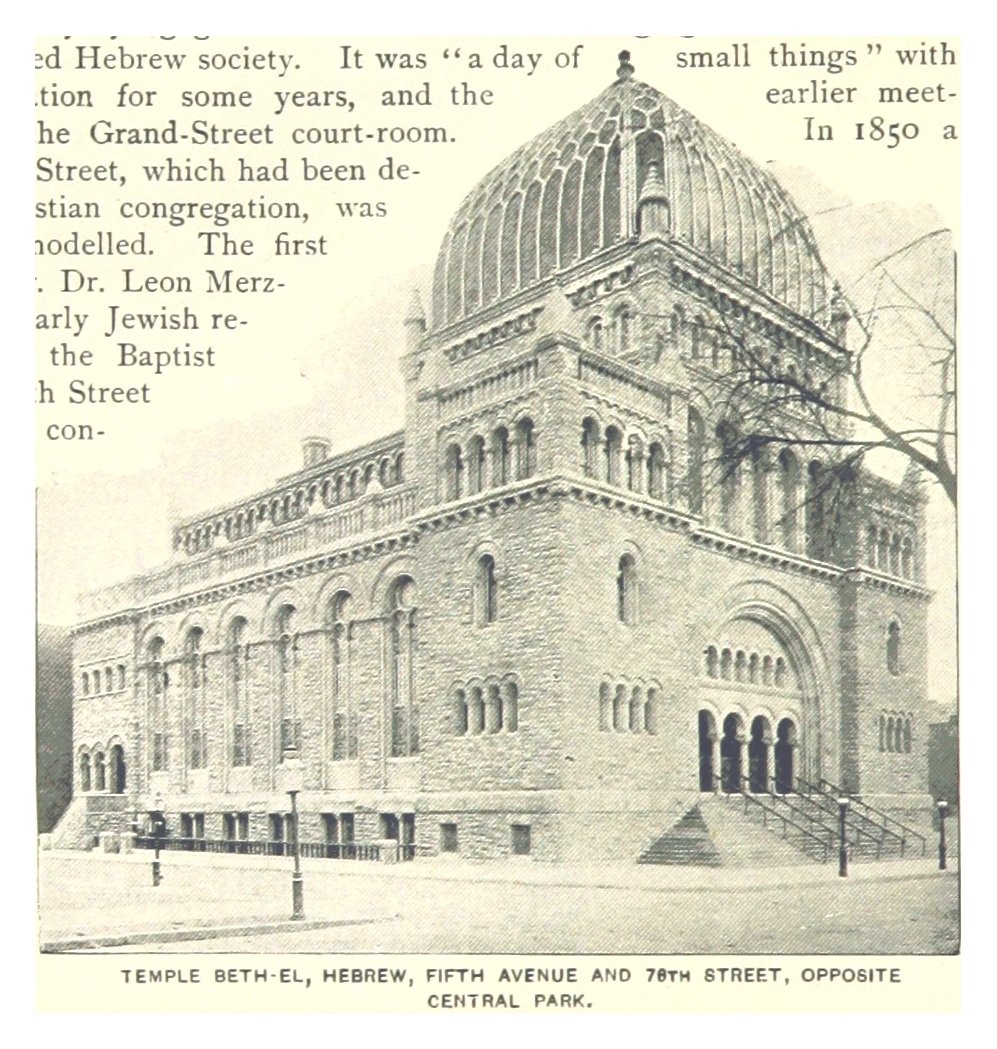
Temple Beth-El Visiting Hours, Tickets, and New York City Historical Sites Guide
Date: 15/06/2025
Introduction to Temple Beth-El: History, Significance, and Visitor Information
Temple Beth-El is a cornerstone of New York City’s Jewish heritage, renowned for its historical importance, architectural splendor, and vibrant community life. Though the original Temple Beth-El on Manhattan’s Upper East Side was demolished in 1947, its influence continues through its successor, Temple Emanu-El, and through other congregations bearing the Beth-El name across New York and surrounding regions. The Beth-El legacy encompasses diverse architectural styles, including the iconic Romanesque Revival structure of old Manhattan, the modernist sanctuary in Chappaqua designed by Louis Kahn, and the Moorish/Egyptian Revival gem of Young Israel Beth El in Borough Park. These enduring institutions represent over a century of religious devotion, cultural expression, and architectural innovation. This comprehensive guide details visiting hours, ticketing, accessibility, guided tours, travel tips, and highlights, ensuring your visit to Temple Beth-El and its affiliated sites is both memorable and meaningful (Wikipedia; Sideways NYC; ArchDaily; Young Israel Beth El of Borough Park).
Table of Contents
- Introduction
- Historical Roots and Evolution
- Architectural Highlights
- Visiting Information
- Cultural and Religious Significance
- Visitor Etiquette and Practical Tips
- Nearby Attractions
- FAQ
- Conclusion & Call to Action
Young Israel Beth El of Borough Park: Hours, History & Tips
A Historic Synagogue in Borough Park
Young Israel Beth El of Borough Park stands as one of Brooklyn’s most significant Orthodox synagogues. Founded in 1902, the original Temple Beth-El quickly became a spiritual and cultural hub for Borough Park’s Jewish community. The first brick synagogue was built in 1906 at 12th Avenue and 41st Street, now the neighborhood’s oldest surviving synagogue structure, serving today as Chevra Anshei Lubawitz.
The current three-story synagogue on 15th Avenue, constructed between 1920–1923 and designed by Shampan & Shampan, is celebrated for its Moorish and Egyptian Revival elements—ornate arches, decorative motifs, and a distinctive historic presence. In 2010, it was listed on the National Register of Historic Places.
Facing demographic changes in the 1980s, Temple Beth-El merged with the Young Israel of Boro Park (established in the 1930s), forming today’s Young Israel Beth El of Borough Park (YIBE). This congregation has nurtured a rich musical tradition, with renowned cantors like Mordechai Hershman, Moshe Koussevitzky, and Benzion Miller.
Visitor Information
- Visiting Hours: Primarily open during religious services (weekdays, Shabbat, Jewish holidays) and special events. Always check the YIBE website or contact the synagogue for up-to-date hours.
- Admission: Free for services and visits. Group tours should be arranged in advance.
- Accessibility: The building accommodates visitors with mobility needs; please confirm specifics in advance.
- Photography: Restricted, especially during services. Ask permission before taking photos.
- Guided Tours & Events: Offered occasionally—check online calendar or social media for updates.
- Nearby Attractions: Explore Borough Park’s kosher restaurants, Jewish bookstores, and other synagogues for a fuller cultural experience.
Virtual and Visual Resources
Many interior and exterior images, as well as occasional virtual tours, are available on the synagogue’s website and social pages.
FAQ
- Best times to visit? Shabbat and holidays are vibrant, but verify hours first.
- Admission fee? None; donations appreciated.
- Wheelchair accessible? Yes, but confirm ahead.
- Guided tours available? Occasionally, with prior arrangement.
- Photography policy? Ask for permission; limited during services.
Conclusion & Tips
YIBE is a living testament to Brooklyn’s Jewish history. Check service times, respect customs, and explore the neighborhood for a complete experience. For updates, follow YIBE on social media and consider the Audiala app for curated tours.
Official Website: Young Israel Beth El of Borough Park
Additional Resources:
Discover Temple Beth-El: A Historic and Cultural Gem
Overview
Temple Beth-El congregations across New York—spanning Manhattan, Buffalo, Ithaca, Jersey City, Great Neck, and Hornell—offer a rich blend of history, architecture, and communal life. This section explores their roots, architectural highlights, and visitor information.
Historical Roots
These congregations were established by Jewish immigrants seeking inclusive spaces for worship and education. Noteworthy examples:
- Ithaca: Founded 1925, notable for its twelve-sided clerestory and symbolic architecture (PocketSights).
- Buffalo: Established 1847, evolving through multiple buildings to meet community needs (Jewish Buffalo History).
Architectural Marvels
- Ithaca: 1929 design features a red clay-tiled dome and rich symbolic motifs (PocketSights).
- Buffalo: Evolved architecturally to accommodate a growing congregation (Jewish Buffalo History).
- Jersey City & Great Neck: Known for inclusive, progressive environments (Temple Beth-El Jersey City; Temple Beth-El Great Neck).
Visiting Information
- Ithaca: Tours by appointment, Mon–Fri 9 AM–5 PM; donations welcome.
- Buffalo: Events/services open to visitors; tours by request.
- Jersey City & Great Neck: Visiting hours align with services/events; check online for schedules.
Public transit and parking are available at most locations. Explore nearby parks, historic districts, and cultural centers.
Social, Cultural, and Educational Impact
Temple Beth-El congregations foster community through social clubs, choirs, and service initiatives. Education is a central mission, with programs for all ages (Temple Beth-El Jersey City; Temple Beth-El Great Neck). Many sites are recognized on historic registers (PocketSights; Wikipedia: Hornell).
Ritual Artifacts and Artistic Heritage
Admire stained glass, Torah scrolls, and symbolic art—such as Buffalo’s preserved stained glass, now at Temple Beth Tzedek (Jewish Buffalo History).
Leadership and Legacy
Dedicated leaders—rabbis, cantors, and laypeople—are the lifeblood of these congregations, fostering dynamic community environments (Jewish Buffalo History).
FAQ
- Visiting hours? Vary by site; check each website.
- Admission fee/ticket? Usually free; donations welcome; ticketing for special events.
- Wheelchair accessible? Varies, but most offer accommodations.
- Guided tours? Available in many locations by appointment.
Conclusion
Each Temple Beth-El offers a unique window into Jewish heritage. Check official websites for schedules and plan your visit for a rewarding experience.
Temple Beth-El New York City: Architectural Highlights & Visitor Guide
Historical Overview
The original Temple Beth-El at 945 Fifth Avenue was a beacon of Romanesque Revival, Byzantine, and Moorish architecture. Designed by Brunner & Tryon, it was dedicated in 1891 and became a symbol of Jewish identity in New York (Wikipedia).
Design Features
- Exterior: Indiana limestone façade, 51-foot copper dome inspired by Berlin’s New Synagogue.
- Interior: Mexican onyx, Numidian marble, gold leaf, and a custom Odell organ (later replaced by a M. P. Möller organ above the bimah).
Transformation
After merging with Temple Emanu-El in 1927, the original building was used sporadically and demolished in 1947 (Sideways NYC). The new Emanu-El complex at 1 East 65th St. preserves echoes of the Beth-El legacy, including the Beth-El Chapel with a double-dome roof.
Visiting Temple Emanu-El
- Hours: Mon–Fri 10 AM–4 PM; Sun 12–4 PM; closed Saturdays/major holidays.
- Tickets: Guided tours available via Temple Emanu-El’s website; suggested donations support preservation.
- Accessibility: Fully accessible, with ramps/elevators.
- Nearby Attractions: Metropolitan Museum of Art, Central Park.
Special Features
- The Dome: Inspired successor structures.
- Materials: Set standards for synagogue interiors.
- Organ Placement: Enhanced both acoustics and visual focus (Wikipedia).
Visuals
Archival and current photos, plus virtual tours, are available on the official website and in historical archives.
FAQ
- Is the original building open to visitors? No; visit Temple Emanu-El for the legacy experience.
- Guided tours or special events? Yes, at Temple Emanu-El.
Conclusion
Temple Beth-El’s influence endures through Temple Emanu-El—an essential stop for anyone interested in Jewish heritage or historic architecture.
Temple Beth-El in Manhattan Beach and Chappaqua: Visiting Information
Locations
- Manhattan Beach: 111 West End Ave, Brooklyn, NY 11235
- Chappaqua: Renowned for its Louis Kahn–designed sanctuary (ArchDaily)
Getting There
- Manhattan Beach: Subway (B/Q to Brighton Beach), then walk or bus.
- Chappaqua: Metro-North Harlem Line to Chappaqua, then short taxi/rideshare.
Visiting Hours & Tickets
- Manhattan Beach: Shabbat services Fridays 7 PM, Saturdays 9:30 AM. Adult classes Wednesdays via Zoom.
- Chappaqua: Schedules vary; check the website or call ahead.
- Admission: Free for regular services; some events/tours may require registration or fee.
Special Events & Tours
Both locations occasionally offer guided tours focusing on architecture and history. Events are listed on their respective websites.
Architectural Highlights
- Chappaqua: Kahn’s octagonal sanctuary, cubic cupola with 24 windows, four concrete columns, natural wood. Expansion by Alexander Gorlin Architects added glass lobby, classrooms, and more (ArchDaily).
Accessibility
Both locations offer accessible entrances and facilities. For city-wide accessible travel, see Wheel the World: Accessible NYC Guide.
Visitor Etiquette & Tips
- Dress modestly; men may be offered a kippah.
- Ask before taking photos.
- Silence phones; arrive early.
- Non-Jewish visitors are welcome to observe respectfully.
Practical Tips
- Register ahead for classes/tours (Temple Beth-El Manhattan Beach).
- Public transport or rideshare is recommended.
- Expect security checks.
- No on-site dining, but many nearby options.
Nearby Attractions
- Manhattan Beach: Brighton Beach, Coney Island.
- Chappaqua: Village shops, Rockefeller State Park Preserve.
FAQ
- Hours? Manhattan Beach: Fri 7 PM, Sat 9:30 AM. Chappaqua: varies.
- Admission? Free for services; some events may require registration.
- Guided tours? Yes, by appointment.
- Accessibility? Yes, at both sites.
Contact Information
- Temple Beth-El of Manhattan Beach:
111 West End Avenue, Brooklyn, NY 11235
Tel: 718.891.3500
templebethelmb.org - Chappaqua: See ArchDaily for details.
Additional Resources
- Wheel the World: Accessible NYC Guide
- The Globetrotting Teacher: NYC Travel Tips
- ArchDaily: Temple Beth-El Chappaqua
Conclusion: Plan Your Temple Beth-El Visit
Temple Beth-El’s sites across New York offer profound spiritual, cultural, and architectural experiences. Whether attending services, exploring architectural masterpieces, or joining educational programs, visitors are welcomed into a living tradition. For current schedules, tour registration, and more, visit official websites.
Download the Audiala app for curated tours and updates on Temple Beth-El and other New York City historical sites. Follow us on social media for travel tips and exclusive content.
Summary
Temple Beth-El’s enduring legacy is a testament to the resilience and cultural richness of New York’s Jewish community. From the grandeur of old Manhattan and the innovation of Chappaqua to the vibrancy of Borough Park, each site offers unique insight into Jewish life and heritage. For the most rewarding visit, consult official websites for up-to-date information, and consider engaging in special events or educational programs. Enhance your exploration by downloading the Audiala app for exclusive tours and content (Temple Beth-El NYC Wikipedia; Young Israel Beth El; ArchDaily; Sideways NYC).
References
- Wikipedia: Temple Beth-El (New York City)
- Sideways NYC: Congregation Emanu-El New York
- ArchDaily: Temple Beth-El Chappaqua by Alexander Gorlin Architects
- Young Israel Beth El of Borough Park Official Website
